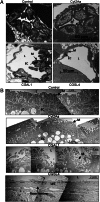Retargeting of the Bacillus thuringiensis toxin Cyt2Aa against hemipteran insect pests
- PMID: 23650347
- PMCID: PMC3666667
- DOI: 10.1073/pnas.1222144110
Retargeting of the Bacillus thuringiensis toxin Cyt2Aa against hemipteran insect pests
Abstract
Although transgenic crops expressing Bacillus thuringiensis (Bt) toxins have been used successfully for management of lepidopteran and coleopteran pest species, the sap-sucking insects (Hemiptera) are not particularly susceptible to Bt toxins. To overcome this limitation, we demonstrate that addition of a short peptide sequence selected for binding to the gut of the targeted pest species serves to increase toxicity against said pest. Insertion of a 12-aa pea aphid gut-binding peptide by adding to or replacing amino acids in one of three loops of the Bt cytolytic toxin, Cyt2Aa, resulted in enhanced binding and toxicity against both the pea aphid, Acyrthosiphon pisum, and the green peach aphid, Myzus persicae. This strategy may allow for transgenic plant-mediated suppression of other hemipteran pests, which include some of the most important pests of global agriculture.
Keywords: aphid management; biotechnology; insect resistance.
Conflict of interest statement
Conflict of interest statement: H.L., K.E.N., and T.M. were employed by Dow AgroSciences while the research described in this publication was undertaken.
Figures





References
-
- Edwards MG, Gatehouse AMR. 2007. Biotechnology in crop protection: Towards sustainable insect control. Novel Biotechnologies for Biocontrol Agent Enhancement and Management., eds Vurro M, Gressel J (Springer, New York), pp 1–24.
-
- Sanahuja G, Banakar R, Twyman RM, Capell T, Christou P. Bacillus thuringiensis: A century of research, development and commercial applications. Plant Biotechnol J. 2011;9(3):283–300. - PubMed
-
- Li H, Chougule NP, Bonning BC. Interaction of the Bacillus thuringiensis delta endotoxins Cry1Ac and Cry3Aa with the gut of the pea aphid, Acyrthosiphon pisum (Harris) J Invertebr Pathol. 2011;107(1):69–78. - PubMed
Publication types
MeSH terms
Substances
LinkOut - more resources
Full Text Sources
Other Literature Sources
Miscellaneous

